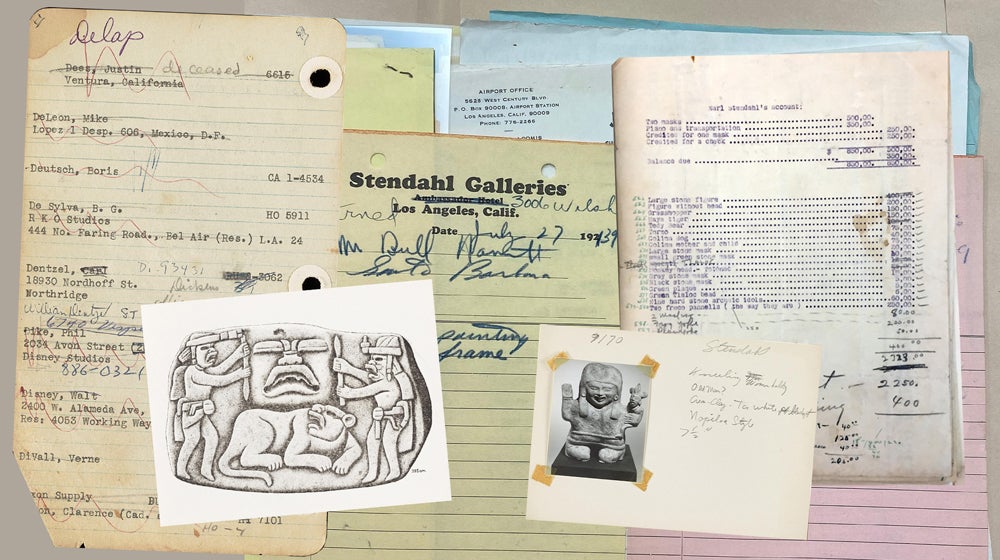The Translator
Rice Ph.D. candidate Bruno Buccalon explores the intersection of history, visual design and cultural heritage to increase access to historical archives.

Spring 2025
By Lynn Gosnell
Photos by Margo Moritz
The way Bruno Buccalon describes it, his daily commute to the Getty Research Institute is less routine and more of a rolling scholarly exchange. Every morning, a Getty Center shuttle stops on Sunset Boulevard near the apartment he’s leasing while on a graduate internship. The stop services Getty Scholar housing residents — a cohort of national and international scholars who are gifted time and resources to conduct research around an annual theme. “So, I often catch the shuttle and get to interact with all the scholars, and I meet people from all over the world doing very interesting research,” Buccalon says.

Buccalon is a Ph.D. candidate in history both at Rice and as part of a dual degree program at the Universidade Estadual de Campinas (Unicamp) in Brazil. As an undergraduate, he studied architecture and urban planning at the Escola da Cidade in São Paulo.
Importantly, Buccalon is a techie.
He brings significant skills in coding, software development and visual design to his work across the humanities. “What I’m particularly interested in is using technology to understand and visualize the past in new ways. The unique thing about Getty is that they are one of the largest cultural heritage institutions developing such technology,” he says.
“[Bruno] understands the need to interpret humanities scholarship and to make it accessible to the public, which is what they’re doing with the Getty Research Institute,” says Rice historian Alida Metcalf. Here are three projects Buccalon is working on this year.

Digital Florentine Codex
For nearly 10 years, the GRI has led a massive research project called the Florentine Codex Initiative — creating a searchable, readable and accessible version of the 16th-century illuminated manuscript credited to Franciscan friar Bernardino de Sahagún and numerous Nahua artists and authors. The manuscript’s Nahuatl and Spanish texts and detailed illustrations provide insights into the Aztec Empire and the Spanish invasion of Mexico.
With greater access to this encyclopedia, the contributions of named and unnamed Indigenous artists and scribes are now coming into better focus. The Digital Florentine Codex launched in 2023, although updates continue. Last fall, Buccalon supported the launch of the new resources page, working on the technical formatting of educational content that includes essays from the research team. He is now collaborating with software developers to improve the citations used across the website.
Pre-Hispanic Art Provenance Initiative
How did pre-Hispanic art and antiquities become such a big focus of museums and private collections in Europe and North America? Since 2019, GRI has been delving into practices of looting, commodification and circulation of Mesoamerican art through the lens of the Stendahl Art Galleries archives, which operated in Los Angeles for more than a century.

This is the current focus of Buccalon’s internship. “This project has the potential to reveal the network of people involved in art trafficking, expand the understanding of these objects by adding historical and cultural context to their definitions, and contribute to current debates on restitution and repatriation,” he says. Buccalon is helping to improve research data management so that these networks of collecting can be analyzed and visualized, in order to tell a fuller story about how cultural heritage is consumed. A major exhibition about the Stendahl Art Galleries will open in 2026.
Latin American and Latinx Art Initiative
This newer initiative aims to foster archival research on Latin American art, especially Central American art, and includes a series of oral histories to document the lives and experiences of accomplished artists and curators.
“I would say that my biggest contribution across the board to all these projects is project management,” Buccalon says. “Under the direction of Alicia Maria Houtrouw, who is the senior project manager for these projects at the Getty Research Institute, I help set up goals, understand the limitations and resources, and make choices about what can or cannot be achieved and plan out the phases.” While this project is just getting underway, Buccalon is excited to highlight the strengths of Latin America’s rich archives by making them more accessible.
Alida Metcalf is the Harris Masterson Jr. Professor of History in the School of Humanities at Rice.
